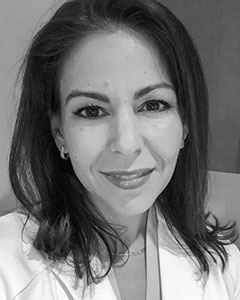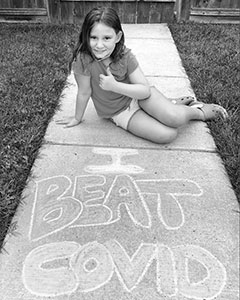In this issue, we talked to Dr. Kimberly Heckert at Thomas Jefferson University in Philadelphia, PA. Dr. Heckert works at the university as well as a subacute rehabilitation facility. During the initial outbreak, Dr. Heckert worked with the facility to provide care to those infected with the coronavirus. At home, she put all she learned from working with her patients to care for her daughter who had contracted COVID-19 from an outside source. The following article is based on her experience as of mid-September 2020.

Kimberly Heckert, MD, FAAPMR
Director, Spasticity Management Fellowship
Clinical Assistant Professor
Thomas Jefferson University
My experience with COVID-19 is a two-fold story. One professional and one personal.
While I work for Thomas Jefferson University, another part of my job is as a director of a physiatry consultation service at a privately-owned subacute facility. Early on in the pandemic, my facility had an outbreak that forced us to make difficult choices. The virus spread so quickly that the facility administration made the decision to evacuate all the healthy patients. Subsequently, we became the first, and possibly the only, all-COVID facility for Philadelphia. The painful reality was that if the facility did not change, it might have been forced to close, as we saw happen to other facilities. It transformed to a place that could handle these patients, and I got to be a part of that process.
My job there changed overnight. Initially, I had to provide services exclusively via telehealth. After several weeks, I was allowed back on-site once a new structure was firmly in place. I would go there on designated days donning a lot of personal protective equipment, see my list of patients and speak with the nursing staff, therapists and staff physician. I didn't eat, drink or go to the bathroom while I was there, and when I was done taking care of patients, I went through a decontamination procedure.
For months while I had been working in this COVID-19 facility, I had taken great care to not get the virus, to not bring it home to my family. However, despite all my efforts, my daughter contracted COVID-19. My university put me through weekly testing to make sure that I didn't bring the virus back to the university and become some kind of "super spreader." My negative tests confirmed that she did not get it from me. She got it from her babysitter while I was working. My home, my safe haven, had been infected.
When we found out that our babysitter had symptoms, we immediately quarantined. We found that (the babysitter) was positive. A couple of days later, my eight-year-old daughter was positive, while I and the rest of my family members remained negative. And so, she subsequently became ill.
I had to be home with her for 17 days. I took a leave of absence and had to care for my daughter the very same way that I care for patients on the rehab facility with COVID-19. Thankfully, I already had months of practice and hundreds of patients to know how to safely protect myself. For me, this meant a lot of precautions, PPE, showers, and bleach. We were able to quarantine her in her room, and in the end, none of my other family members contracted COVID-19.
She recovered from what would have been considered a mild case of this illness (she did not require supplemental oxygen therapy or hospitalization). But I'll tell you, as a mom, my kid was really sick. To know what this disease can look like and watch your child become ill was very emotionally difficult.
I ended up sharing my experience with my local community, and that was a decision that my husband and I wrestled with for a little while. We were concerned that our daughter might be stigmatized in our community and in her school, but ultimately, I knew that we would not be the last family in our town to go through this experience. I wanted people to be informed that there are ways to stop the spread of coronavirus, even within one's own home, and to care for a family member safely. And I wanted to be a resource for other families because I so desperately wanted to bring some good out of this ordeal. Since that time, I have received calls from neighbors with questions when someone has been exposed, and have leant out my pulse oximeter a dozen times.
This experience just affirmed for me that the methods I am using are appropriate. I had months of weekly negative swabs and I never contracted COVID-19 from my daughter or a patient. Personal protective equipment works and basic safety precautions work. We have to help people understand that we have a collective responsibility as a society to: a) Prevent the spread of this disease and b) care for the people around us who are affected by it. But how do you get people to buy into this concept? I'm still chewing on that.
Reflecting further, what really stands out for me is the disparity of resources and the impact that can have. Professionally, there were certainly other places I could spend my time, but it didn't feel right to me to abandon that facility. The impact of this facility in inner city Philadelphia is significant. This is a place where patients with very little resources go in their most desperate chapters of life to get well.
And while the experience with my daughter was hard, and as hard as it was, I was prepared. I had PPE. I had enough bedrooms in my house so that everybody could truly separate. I had enough bathrooms at my house that we didn't have to share a bathroom with my daughter who was infected. I had an iPad for her that she could use to call my cell phone when she needed me.
It was obvious to me this would look extremely different for a family with lesser resources. If we didn't have the ability to separate, to keep ourselves safe, the virus would have infected my entire household. I believe that is what happens to people who are less fortunate, who have less resources. They're going to have worse outcomes.

Because of the coronavirus, I believe that the transition to value-based care medicine is already happening. We are moving toward providing more acces, particularly receiving medical care from home, and I feel that this is a good thing. And yes, I do believe that it creates opportunity for physiatrists. In some ways, we could become even more accessible for patients, particularly those with accessibility challenges, and I do believe we may also be considered earlier on the patient continuum as a result of the transition.
As physiatrists we need to get better at articulating what we do, why we do it so well and why no one other than us can do it. The coronavirus has resulted in significant morbidity for many of its survivors, really the true extent of which is not yet realized, but we are no strangers to the rehabilitation of conditions resulting in morbidity. Now is the time to rise up and do what we do best. We need to position ourselves to be leaders in all rehabilitation settings - acute, subacute, outpatient - and across the entire care continuum. We do this well in acute rehab, but I think there are some subacutes where that is not the case. I was very fortunate, in this case, for my facility, that I was able to be part of the leadership for our transformation. When physiatrists get left out and deemed "non-essential," that's an atrocity.
We are the experts in treating the complications of immobility, which is what we are seeing in a high number of patients who end up in rehab after COVID-19 infection. They are patients who have had long ICU courses, often requiring intubation and/or suffering from thromboembolic events or other organ system damage. Physiatrists are not strangers to this work.
The entire rehab process is better with physiatry oversight because patients and facilities benefit when physiatrists are making the decisions. We look at the root causes for functional loss and we are very in-tuned to what the barriers are to getting home. And we are very much in-tune to developing a plan around eliminating those barriers - either making accommodations or specific rehabilitation measures.
Physiatrists have proven we can adapt to meet the needs of our patients through the ways that we have altered our practices. But as we move forward, we all need to be even more mindful of healthcare disparities amongst people with disabilities. We have to ensure access for our most vulnerable. Telehealth certainly helps, but it still does not address the fact that underprivileged groups may not have access to that technology.
We need ownership in rehabilitation settings. We need to be the physician leaders in these arenas. We also need to mobilize our units to be present earlier in hospital stays through meaningful rehabilitation consultation. And we need to open our outpatient practices to emerging technologies that improve access.